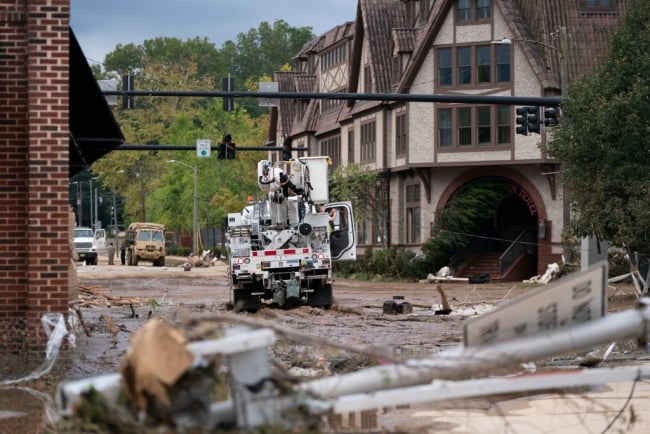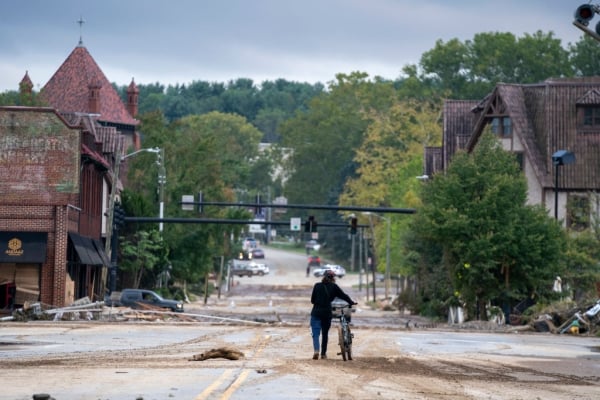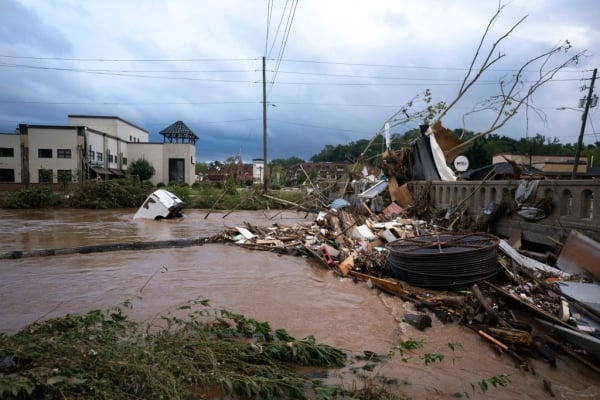You have /5 articles left.
Sign up for a free account or log in.

The flash flooding from Hurricane Helene has left many small North Carolina mountain towns and even larger communities like Asheville in shambles, with homes washed out and debris scattered across roadways.
Sean Rayford/Getty Images
The storm may be over, but the cataclysmic flooding and power outages that Hurricane Helene unleashed have left university campuses across western North Carolina in shambles and many students disconnected from their families.
Elisa Kiser Kennemer was lucky enough to have received a text from her son Cole, a student at Appalachian State University, when she posted a Facebook update for friends and family Saturday. But that one message was all she had.
“I don’t know much as there is no cell phone coverage and I haven’t been able to talk to him,” she wrote. “Please send some love to the mountains of NC.”
She later confirmed that his apartment and car were on high ground so they’d been spared major damage, but she still had not heard his voice.
“It really was a bit chaotic,” Kennemer wrote to Inside Higher Ed. “Obviously it could have been … worse.”
For others, it was. Brandi Hayes, a resident of Asheville, which was pummeled by the storm, told The Citizen-Times that she’d tried to call her 18-year-old daughter, a student at Western Carolina University in Cullowhee, but received no answer.
Waiting in a long line at a local grocery store for food and water, she broke down in tears as she discussed the mental toll the disaster had taken.
“We keep talking about [what] we’re thankful for,” Hayes told the Citizen-Times. “Some people don’t have homes.”
Over the last three days, flash floods, landslides and fallen trees from the storm have cut off many of the state’s major roads and highways, damaged buildings—including academic facilities—and washed out scores of homes.
By Monday night, at least 121 people had been reported killed across six states, including 35 in Buncombe County, where the University of North Carolina at Asheville is located. As residents begin to dig out, state, city and university leaders say one thing is becoming clear: There’s a long road of recovery ahead.

Many students and staff were able to evacuate the areas before the storm, but some are now stuck in towns like Asheville, where road access is limited because of the flood.
Sean Rayford/Getty Images
“The level of devastation it has brought to our region is massive. Some of our staff members have significant damage to their homes, and some haven’t seen their families since the storm began,” Appalachian State University chancellor Heather Norris wrote in a statement Saturday. “Assessment of the damage and recovery from it will take time.”
Colleges throughout the region, including Appalachian State, Western Carolina, UNC Asheville, Warren Wilson College and Blue Ridge Community College, are closed at least through the rest of the week. But it could be much longer until they reopen.
In some cases, as at App State, residence halls as well as a central dining facility have remained safe and largely unaffected. However, maintenance crews are roping off areas that are less stable and community members have been advised not enter those zones; anyone doing so may face disciplinary action or possible arrest.
Just 20 minutes to the southwest, Lees-McRae College evacuated all students. The National Guard had to remove seven stragglers by air from the small, private college after flooding cut off all road access.
The institution is closed through the end of the week and then anticipates “being online until the Town of Banner Elk can restore water and sewer service and until Mountain Electric can fully restore power to campus,” college president Lee King announced Sunday morning.
UNC Asheville also announced Monday afternoon that “due to resource constraints and diminishing life safety infrastructure,” it was working to identify relocation options for all remaining students. University spokesperson Michael Strysick told The Citizen-Times that approximately a quarter of students living on campus left before the storm, leaving about 1,200 still to be evacuated.
The university will also provide mental health support for students through partnership with the East Carolina University Center for Counseling and other UNC system student health centers.
“We’re doing the best we can under difficult circumstances,” Strysick said.
Some parents have taken to social media to ask for guidance on the best driving routes to pick up their children from campus. But the state Department of Transportation repeated Monday that all roads in the region should be considered closed and that “non-emergency travel is prohibited.”

Colleges across western North Carolina are closed at least through the week, but damage to towns like Asheville has left many wondering if it will take much longer to recover.
Sean Rayford/Getty Images
Katelyn Lillard, a senior at UNC Asheville, said she’s glad she made it out when she did. The university had sent emails early on recommending students go home for the weekend if possible, but Lillard “didn’t think much of it” at first and decided to stay.
“My roommate and I were making jokes, trying to make the best of the situation. We started placing bets on when the power would come back on and if classes would resume on Monday,” she wrote in an email to Inside Higher Ed.
It wasn’t until later in the day, when she had to walk hours to a fire station to access an emergency internet hotspot to contact her family in Charlotte, that fear started to set in.
“That’s when it hit me. This wasn’t just a small storm, it was far more serious,” she wrote. “It was upsetting to see the huge crowd of people, trying to contact their children, parents, etc. Luckily, I ran into a close friend who offered me a ride to Charlotte.”
Outsiders looking in “cannot fathom the sheer destruction and devastation,” Andrew Koricich, a faculty member at Appalachian State, wrote in an email. He evacuated to Pennsylvania on Sunday to stay with family but said the university has really stepped up to care for the community, turning the convocation center into a Red Cross emergency shelter, providing hot meals to any locals in need and distributing as many additional supplies as possible.
“Everyone is just trying to take care of each other and their neighbors as best we can,” he wrote. “So, I’m sure faculty and staff are trying to help students, but our whole community is in some stage of ‘survival mode,’ irrespective of whether people are affiliated with the university or not.”
Other universities throughout the UNC system are chipping in where they can as well. Police personnel from Winston-Salem State and North Carolina A&T State Universities sent law enforcement personnel to Asheville to assist with recovery operations. North Carolina State University sent a team of student affairs professionals, facility crews and equipment. And the system office has deployed IT experts to help restore internet service.
Some colleges have also started to see support from alumni, unaffected North Carolinians and others through various independent donation pages, as well as the overall North Carolina Disaster Relief Fund.
And university officials are exceedingly grateful for the assistance.
“We are in the midst of a unique tragedy for Western North Carolina. Currently, it is difficult to comprehend the extent of the devastation throughout our region,” John Dougherty, UNC Asheville chief of staff, wrote to Inside Higher Ed. But the university community has “received tremendous support,” he noted.
UNC system president Peter Hans said the response efforts were underway “even before the storm hit,” but they still have a long way to go. “The scale of this disaster is tremendous, and the recovery is going to be long and difficult,” he said.




